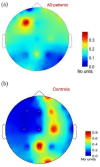The Role of Quantitative EEG in the Diagnosis of Alzheimer's Disease
- PMID: 40804929
- PMCID: PMC12346855
- DOI: 10.3390/diagnostics15151965
The Role of Quantitative EEG in the Diagnosis of Alzheimer's Disease
Abstract
Alzheimer's disease is the most prevalent neurodegenerative disorder leading to progressive cognitive decline and functional impairment. Although advanced neuroimaging and cerebrospinal fluid biomarkers have improved early detection, their high costs, invasiveness, and limited accessibility restrict universal screening. Quantitative electroencephalography (qEEG) offers a non-invasive and cost-effective alternative for assessing neurophysiological changes associated with AD. This review critically evaluates current evidence on EEG biomarkers, including spectral, connectivity, and complexity measures, discussing their pathophysiological basis, diagnostic accuracy, and clinical utility in AD. Limitations and future perspectives, especially in developing standardized protocols and integrating machine learning techniques, are also addressed.
Keywords: Alzheimer’s disease; qEEG; spectral analysis.
Conflict of interest statement
The author declares no conflict of interest.
Figures
Similar articles
-
MarkVCID cerebral small vessel consortium: I. Enrollment, clinical, fluid protocols.Alzheimers Dement. 2021 Apr;17(4):704-715. doi: 10.1002/alz.12215. Epub 2021 Jan 21. Alzheimers Dement. 2021. PMID: 33480172 Free PMC article.
-
Time-Frequency Domain Analysis of Quantitative Electroencephalography as a Biomarker for Dementia.Diagnostics (Basel). 2025 Jun 13;15(12):1509. doi: 10.3390/diagnostics15121509. Diagnostics (Basel). 2025. PMID: 40564830 Free PMC article. Review.
-
Recent advances in the detection and management of motor dysfunction in Alzheimer's disease.Psychiatriki. 2025 Jul 2;36(2):97-100. doi: 10.22365/jpsych.2025.012. Epub 2025 May 14. Psychiatriki. 2025. PMID: 40400272 English, Greek, Modern.
-
Prescription of Controlled Substances: Benefits and Risks.2025 Jul 6. In: StatPearls [Internet]. Treasure Island (FL): StatPearls Publishing; 2025 Jan–. 2025 Jul 6. In: StatPearls [Internet]. Treasure Island (FL): StatPearls Publishing; 2025 Jan–. PMID: 30726003 Free Books & Documents.
-
Plasma and cerebrospinal fluid amyloid beta for the diagnosis of Alzheimer's disease dementia and other dementias in people with mild cognitive impairment (MCI).Cochrane Database Syst Rev. 2014 Jun 10;2014(6):CD008782. doi: 10.1002/14651858.CD008782.pub4. Cochrane Database Syst Rev. 2014. PMID: 24913723 Free PMC article.
References
-
- Prince M., Wimo A., Guerchet M., Ali G.C., Wu Y.-T., Prina M.W. World Alzheimer Report 2015: The Global Impact of Dementia. Alzheimer’s Disease International; London, UK: 2015.
-
- McKhann G., Knopman D.S., Chertkow H., Hyman B.T., Jack C.R., Jr., Kawas C.H., Klunk W.E., Koroshetz W.J., Manly J.J., Mayeux R., et al. The diagnosis of dementia due to Alzheimer’s disease: Recommendations from the National Institute on Aging-Alzheimer’s Association workgroups. Alzheimer’s Dement. 2011;7:263–266. doi: 10.1016/j.jalz.2011.03.005. - DOI - PMC - PubMed
Publication types
LinkOut - more resources
Full Text Sources


